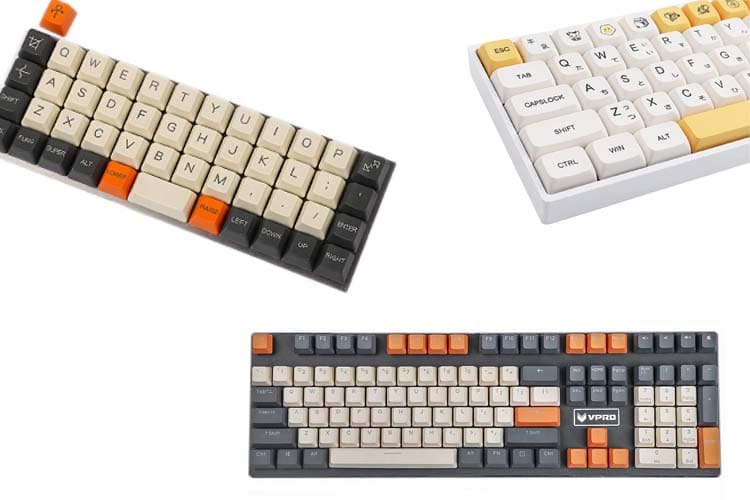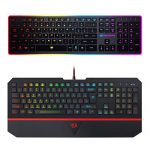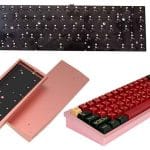
Most enthusiasts judge the quality of a custom keycap set based on the plastic material used. However, the plastic material is only one of the many factors that affect the quality of keycaps. There are other factors that should be noted, such as the durability of the legends and the process used to print the legends.
Different keycaps utilize different printing methods for the legends. Some use high-quality double-shot legends while others tend to go for dye sublimation or other lower-cost methods. The different printing methods will ultimately affect the durability of your keycap legends, Some may fade over time while others are technically impossible to rub off.
The fact that keycap legends highly determine the look of the keycaps is enough of a reason to keep an eye on the printing quality and process used for the keycap legends. In this article, we will be going through some of the commonly used keycap legends.
We’ll go through concepts such as double-shot, dye sublimation, pad printing, laster-etching, and many more. And by the end of this article, consumers should have a better idea of what keycap legend printing method is the most durable.
What are Keycap Legends?
The printed fonts inscribed or etched on the keycap’s top, front, or side are called legends. These legends are usually imprinted through dye-sublimation, laser printing, double-shot molding, pad-printing, etc. The type of plastic material used in making the keycaps normally decide which type of printing should be used to achieve a better and more durable keycap legend.
Keycaps can be made out of anything, but they are usually made out of PBT (Polybutylene Terephthalate) or ABS (Acrylonitrile Butadiene Styrene), commonly used materials to manufacture custom keycaps for mechanical keyboards. Keycaps made out of ABS plastic exhibit a more vibrant color but tend to get shiny and slippery after long use since you are polishing the keycap with your fingers. On the other hand, PBT doesn’t wear or shine that easily but cannot achieve the same vibrancy as ABS and is more prone to warping.
Each may have its pros and cons, but the printing process is just as important aside from the plastic type. It has a significant effect on the keycap legend’s durability. Some printing is just simply dying the top of the keycap, which fades eventually. Still, to attain a more durable keycap legend, another process inscribes the legend into the keycap itself, which prolongs its lifespan, or for most, it never comes off.
Types of Printing and their Durability
Double-shot

Double-shot molding is known to produce the most durable legends. This is usually the process used on higher-end keycaps such as GMK. It is also the most expensive and inefficient molding process due to the more complex methods used for double-shot legends.
This process combines two different plastic molds with different colors instead of exactly printing the legend onto the keycap. Usually, the first shot of the layer creates the legend; then the second shot is molded around it, making the keycap hull. In this method, the legend will surely never fade nor disappear because it is a different part of the plastic merged with the shell of the keycap, which creates a high-contrast legend.
Dye-Sublimation

Dye-sublimation is used in the majority of the more advanced keycaps. They aren’t up to the same standards as double-shot keycaps, but they can certainly hold their own. They are a significant step above pad printing but still not as good as double-shot keycaps.
This way of keycap legend printing uses a dyed template wherein heat is applied to transfer the design to the surface of the plastic keycap. The dye is absorbed by the keycap material and is pretty much permanently stained into the keycap.
You can say that the legend is like being tattooed into the keycap. This process causes the dye to seep into the plastic, which is different from other types of printing where it forms a layer of paint on top of the plastic.
Dye-sublimation cannot wear off that easily as paint, and users can easily imprint multiple colors. However, the dye used for the legend must be darker than the keycap it is being dyed into. This implies that you cannot use dye-sublimation to black keycaps because nothing is darker than black.
Since it uses heat to apply the design, PBT plastic keycaps are usually used because they have higher heat resistance than other plastic materials. It may be harder to wear off, but the legend may have softer edges over time, and the dying process may result in fuzzy or blurry legends. It is more durable than other printing methods like pad printing and laser printing which is why it is more expensive but cheaper than the double-shot method.
Pad Printing
Pad printing is the cheapest and most common type of printing. The process is simply done by pressing a pad with ink onto the keycaps. A legend template is first inked on a printing plate then transferred onto the keycap surface using a rubber pad by pressing first from the printing plate then to the keycap. This form of printing has been popular way back in the 1990s.
The method is flexible which can adapt easily, and manufacturers may print any image or letter of any color they like. However, because of the process of just adding another layer for the legend, the printed characters are slightly raised, changing the feel of the keycap. For that reason, this technique is susceptible to fading with moderate use in the long run. In time, the legends will disappear after enduring enough wear.
To increase its longevity, some manufacturers thought of adding a clear coat on top of the legend. It may not live for a lifetime, but it will ensure that the legend will last longer than those pad printed without coating. Pad printing may not be as durable as other printing methods, but you can expect a decent lifespan with quality ink.
UV Printing
UV printing uses UV (Ultraviolet) lights to cure or dry UV-sensitive substances as the legend onto the keycap. As the printing machine distributes the ink on the surface of the keycap, specifically designed UV lights follow immediately behind to cure the ink straight away. The finished product may have a dotted texture because the color is produced through the dithering of pigment inks. A mixture of colors can be applied instead of single color normally allowed on other types of printing.
The process requires darker color on light keycaps to imprint the legend successfully. If the keycap is dark, they are first treated with a lighter colored layer where the legend is then printed. Since it does not involve heating the keycap surface, the final result produces a raised gloss layer of legend. The design of the surface is vividly embossed and can be felt while typing. This may not guarantee the durability of the legend and will come off easily after extended use.
In a really small quantity, UV printing can be achieved by just putting the keycap and the adhesive on top of it under a fixed UV lamp for a certain amount of time. However, using a machine dedicated to UV printing is advantageous for countless keycaps because the conveyor belt ensures a consistent exposure time to attain a better result.
Engraving

Engraving is a time-consuming process, which is why it is not very popular. It is mainly reserved for mechanical keyboard enthusiasts. Still, it’s not widely used because it also has its disadvantages.
The process involves a machine where the characters are mechanically engraved, and the space left is filled with paint of any color. It may be a bit durable given that it is permanently etched into the body of the keycap though the feels may not be as smooth as new if the paint sweeps off.
Dirt may also accumulate in the hollow space, which does not come off that easily. As a result, unlike other methods, this type of printing is not in demand among users.
Laser-Etched/Laser Printing

Laser printing is considered to be one of the most commonly used methods for keycap legends. The process utilizes a laser beam to imprint the legends onto the keycap surface, marking straight-cut characters. The product may last longer than pad printing, but it is more expensive. If compared to dye-sublimation or double-shot molding, laser printing is less durable.
It is divided into three common practices, but they are almost similar. The frequently used when dealing with light-colored keycaps is laser etching to create contrast. It is the charring or burning of the surface of the plastic, leaving a dark charcoal-like color legend. This is the same as the second method, but the grooves are filled with paint in any color this time. Unlike the first one, this technique is best to use on dark-colored keycaps.
Not very identical with the other two, laser engraving needs to coat the keycap first with a mixture of black UV paint. The laser then gets rid of the paint following the design of the legend. This practice is normally used to make backlit keycaps wherein the keycap is transparent to let the RGB light illuminate through where the paint was erased.

The KBE team is dedicated to sharing our knowledge and creating useful resources about computer keyboards. This article was written as a team collaboration, combining our knowledge and years of experience using, building and modding keyboards. Meet the team here.



